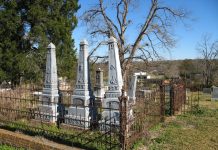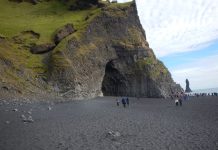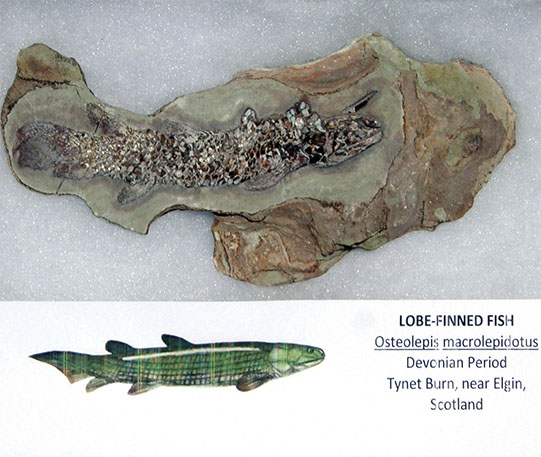
By Jim Brace-Thompson
Much Scottish blood flows through my veins. Thus, I’m unabashed in promoting the once and future independent nation of Scotland to anyone and everyone who will put up with my raves. The Scottish connection flows not only from my Fordyce grandmother and my wife’s Campbell roots (sincere and eternal apologies to Glencoe) but also from our one-year-old Scottish grandson who will serve as a pull to the Caledonian nation for some time to come.
These Scottish roots didn’t become personal until not so many years ago via our daughter, Hannah.
Establishing New Generation of Scottish Roots
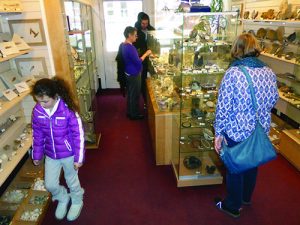
Hannah had moved to Edinburgh, Scotland, from Berlin, Germany, precipitating a trip by Nancy and me in May 2015. We had journeyed from California to bear witness at her wedding with Peter—but not before checking Google to discover a true-blue, bona fide rock shop located within walking distance from Hannah and Peter’s apartment. Thus, our first encounter with the little shop called Mr. Wood’s Fossils located at 5 Cowsgatehead in the Grassmarket of Old Town Edinburgh, the old “hanging district” for public executions but now a hip tourist destination.
Forget wedding flowers, caterers, bagpipers, kilts, and associated matrimonial arrangements! Within hours of arrival, bleary-eyed but rockhound-alert, Nancy and I were checking out shelves at Mr. Wood’s Fossils, a classic rock shop with a view of Edinburgh Castle from the street out front in an enchanting district of cobblestone lanes that inspired J. K. Rowling for the Harry Potter novels. Our daughter hurried us through this initial visit, insanely insisting wedding arrangements must be made, but this proved to be the first of many visits to Mr. Wood’s. After 2015, we returned in 2016 and 2018, with yet another visit planned for the 2019/2020 holiday season. (In between, we’ve enjoyed a Christmas gift from Hannah and Peter—a fine Devonian fossil fish—courtesy of Mr. Wood’s.) Although our trips have become a near-annual occurrence, our 2015 visit remains memorable in that it was our very first encounter with Scottish rocks and fossils and their glorious history in the annals of geology.
That 2015 visit focused on agates. (See the April 2016 issue of Rock & Gem.) We had made connections with the Scottish Mineral & Lapidary Club (SMLC) a in the nearby harbor town of Leith, where, after our initial brief visit to Mr. Wood’s, SMLC members showed us spectacular displays of Scottish agates and minerals in their little nonprofit club museum. Impressed by what we saw, we returned to Mr. Wood’s, given that its web site indicated Scottish agates could be had and because we had fleetingly seen a few on display.
Mr. Wood’s Fossils’ Foundation of Service
Before we get to those agates, though, some background. Mr. Wood’s Fossils was founded by Stan Wood, a self-taught fossil collector who passed away in 2012. The UK has seen a long, fine tradition of amateur and self-taught paleontologists, such as stonemason Hugh Miller, Mary Anning (of “she sells seashells by the seashore” fame), and Stan Wood. Nigel H. Trewin published the book Scottish Fossils in 2013, which he dedicated to all such collectors, “and particularly to the late Stan Wood for his many important finds and excavations that have contributed so much to science in recent years.” Contrary to many other technical sciences, Trewin notes how “paleontology is a science where expert amateurs can make a valuable contribution,” and he heaps tribute on responsible, expert commercial collectors, singling out Stan Wood “and the superb finds he made.”
Stan’s efforts as a collector proved significant, indeed. For instance, in 1984 he discovered the skeletal remains of Westlothiana lizziae on a small rock slab that would likely have gone unnoticed by most of us. Informally called “Lizzie,” this find proved to be a key link between fishy amphibians and their land-loving reptilian descendants. Museums and collectors as far away as Japan lusted after Lizzie, but Stan wanted her to stay in Scotland, so he sold his slab to the National Museum of Scotland for a quarter of what he could have received from the many foreign offers.
There was a moment in Earth history between the appearance of fish and the sudden appearance and evolution of tetrapods, or critters with four limbs, that led to none other than us. But the fossil record of that transition at the end of the Devonian and the beginning of the Carboniferous Period was a frustratingly blank slate. Paleontologists even put a name to their frustration, referring to this mysterious period as “Romer’s Gap”. Stan Wood’s collecting efforts with Lizzie and other finds helped to fill that gap. Thus, while considered an amateur, Stan entered the hallowed halls of truly significant paleontologists, and his finds prompted renewed studies of the “East Kirkton Quarry” that had been known to paleontologists since 1825 but whose real significance was not revealed until Stan came along.
Fascinating Discoveries
Stan’s other discoveries include the “Bearsden Shark Dig” that produced a strange shark Akmonistion from the Carboniferous Period that today serves as the symbol for Mr. Wood’s Fossils. Its outline hangs from a pole above the shop door, is painted on the shop window, and is engraved on the shop business cards and website (www.mrwoodsfossils.co.uk).
Stan kept his many finds in his garage in the West Lothian town of Livingston while providing specimens to museums for research and display. Folks who saw his collection always encouraged him to open a shop to share his discoveries with the public. He finally did so in 1987, starting with just three or four shelves of self-collected specimens until he found a wholesale supplier in the UK to expand his inventory.
While Stan focused his primary attention on fossils, we were pleased to see that in addition to fossils, current proprietor Matt Dale had varied Scottish minerals, as well as a couple of Scottish agates, on display. On our second visit to the shop, Matt himself was manning the cash register, and when we expressed interest about his shelves of local material and asked about seeing more Scottish agates, he opened a trapdoor on the floor, descended out of sight down steep creaky stairs, and reappeared with a flat holding an assortment of small Ayrshire agates from southwest Scotland that had been cut and polished on a lap.
We pawed through the specimens, seeking agate halves that matched, then trying to figure out the exchange rate between dollars and pounds. Most specimens were no larger than the diameter of a quarter. When we asked how one acquires really big Scottish agates like those we had seen in books and Leith, Matt paused before slowly replying. “You wait,” he said, “…for someone…to die.” Apparently, Scots are a frugal lot who hold onto the limited supply of agates nature hath given them!
Making Plans to Meet at Mr. Wood’s Fossils
Before our last trip to Scotland in April 2018 to visit our newborn grandson Lukáš, I
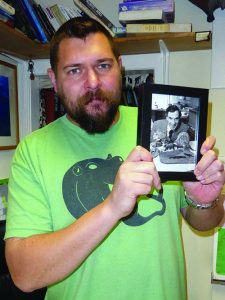
had contacted Matt via email to arrange an in-person visit and interview. This actually extended into two visits to his fantastic shop. The first day we visited, Matt was wearing a motorcycling T-shirt. In keeping with his dress, he proved to be relaxed, informal, and highly friendly and approachable.
During the course of our conversation, I learned that Matt has been involved in the shop for decades now in an effort to keep alive this true Edinburgh tradition. He became the general manager in 1998, while Stan Wood still owned the shop, and in 2006 he bought the business in full. Meanwhile, Stan continued his collecting passion until he passed away in 2012 and was making important finds in the so-called Border Region between Scotland and England. Some of his finds were featured in a special temporary exhibit I saw in 2016 at the National Museum of Scotland, and the museum had done a similar smaller exhibit that Stan himself was able to see and appreciate before his passing.
Given that Mr. Wood’s Fossils started with just a few shelves of Stan’s personally collected treasures, I asked Matt about how the shop has grown and evolved over the years. When Matt started as Stan’s right-hand man, Stan asked him to make a list of changes he might recommend. The first was standardizing labels.
Matt suggested they prepare labels similar to a museum tag with information such as name, age, and locality for fossils. One of my pet peeves is dealers who treat rocks like so much powdered soap; that is, as a commodity with no care given to provenance. In fact, I no longer purchase specimens at rock shops or gem shows that lack proper labeling, so I fully acknowledge, appreciate and endorse this move by Matt. Not only does it provide good information for customers, but it also elevates their mineral and fossil specimens beyond the category of a mere commodity and shows respect for each item as a scientific object deserving of archival documentation.
Insiders’ Exploration of Fossil Inventory
Matt’s second recommendation was to make specimens hands-on. Originally, everything was tucked away in glass cases. Having sponsored, run, and attended gem and mineral shows where specimens have been surreptitiously hijacked by shoplifters, I can appreciate this instinct. Indeed, the higher quality, higher valued material is still behind glass at Mr. Wood’s, as well it should be. But Matt knew that customers like to pick up, touch, and examine specimens. Not everything need be tucked behind a glass barrier. Making specimens touchable and tangible helps increase their appeal, even if some, unfortunately, might sprout legs and walk.
Over the years, Matt also expanded the inventory to include other items, such as
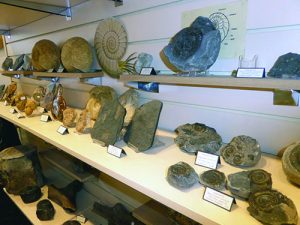
meteorites and jewelry. This single decision proved to be a big help in keeping a steady cash flow. It broadened the shop’s appeal beyond the small niche market of fossil and mineral specimen collectors to a much wider general-interest market. Not everyone is interested in an aquamarine crystal in matrix, no matter how perfect the crystal, but most everyone is interested in a faceted aquamarine attractively set in a sterling silver mount that can be immediately worn around the neck as you exit the shop. The same goes for a trilobite. Not many want a fossil ‘bug”. But a unique stone critter set in a silver mounting? Go for it! In short, this one simple decision by Matt made Mr. Wood’s Fossils a shop that anyone and everyone can enjoy. This is a crucial consideration in a high rent district such as the Grassmarket, where you would like to provide something of interest to every resident or tourist who happens by.
Matt does hold the line, though, on just how far he’ll expand. For instance, he avoids so-called “healing stones” and the pseudo-science that has evolved around them. Many minerals sold in the shop are considered by some to be healing stones, such as quartz or amethyst, and Matt will tell customers how they might obtain information on such stones, but he prefers to stick to the scientific aspects of mineralogy and paleontology. This jibes with the whole look-and-feel and philosophy of Mr. Wood’s as not just a shop but also as a sort of science museum.
Growing Connections
Ever since Stan Wood first connected with a wholesale supplier in the UK and ever since Matt came on board, the connections and the inventory have grown ever more diverse. Nowadays, Matt travels each February to the United States to attend the famed international rock shows in Tucson, Arizona. He generally goes for about a week and a half to the varied satellite shows. In addition to forging new connections, he has specific people with whom he reconnects, such as Jim Tynsky whose Tynsky’s Fossil Shop I have visited in Kemmerer, Wyoming. From Jim, he gets Green River Formation fossil fish, and during our interview, he admitted that someday he would like to collect there himself, more for the sheer fun of collecting than to get specimens for the shop.
In addition to the international shows at Tucson, Matt attends the annual June show in the Alsace region of France. The Saint-Marie-aux-Mines Mineral & Gem Show is billed as “the second-largest mineral event in Europe,” after the Munich shows in Germany. Some 900 exhibitors from around the world attend, including the top mineral dealers in Europe. Attendance is typically in the neighborhood of 25,000. The show is held in the town of Sainte-Marie-aux-Mines in the valley of the Alsace mountains, home to the French-German Funkhauser branch of my family tree. (They weren’t all Scots!) Matt notes that the show basically takes over the town with outside stalls and tents and a very spread out, laid back, and relaxed bazaar-like atmosphere that is highly appealing.
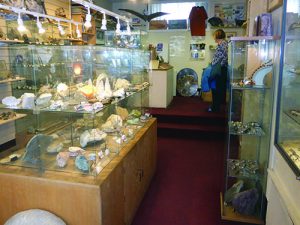
Per Matt, while there are many shops selling gems, jewelry, and healing stones, there are not many “proper” fossil shops in the UK, and it has taken many years to build a supply line for good, high-quality inventory via connections forged during these trips to the U.S. and France.
He would rather bypass middlemen and deal with actual quarry owners and diggers in that he gets a better price, he gets to pick-and-choose for better material, and he gets the “back story” about how the particular specimens were quarried and prepared. All this allows Matt to provide a better level of service in responding to customer queries. As he notes in his shop website, “We go out of our way to hand pick our stock as much as possible, and try to get as close to the original source as we can to ensure we always have a big range of great value and high-quality fossils for sale”.
Appeal of a Wide Assortment
Matt’s shop does offer an assortment that differs from many a shop I’ve seen during my personal travels in places as far-flung as Los Angeles, Hong Kong, Bangkok, New Delhi, London, Boston, and Berlin, where all the merchandise seems to have been purchased from the very same wholesalers. To be truthful, Mr. Wood’s Fossils does stock such “generic” specimens (for instance, Moroccan fossil shark teeth), but also so much more—not only out on the shelves but also beneath that trapdoor for those who inquire. As someone who began my collecting adventures on my belly as a kindergartner picking crinoid stems from our driveway gravel in Illinois, fossils remain my central passion, and it is hard to find a shop with so many fossils in addition to gems and minerals. So hard, in fact, that I had to travel to Scotland to find it!
Given his location in a highly desirable tourist spot downwind from Edinburgh Castle, I asked Matt about his business model and its sustainability. Matt’s most pressing problem is physical space, which he tries to manage by controlling and sticking to high-quality stock and not making unnecessary purchases that won’t turn over in a timely manner. For instance, before going to such venues as Tucson or Saint-Marie-aux-Mines, he’ll prepare a shortlist of needs.
Matt is fortunate to own the first floor and basement of the building housing Mr. Wood’s Fossils. Thus, he has fairly low overhead costs. This is truly significant. I have a friend in my hometown of Ventura, California, who is attempting to start her own rock shop, but rent and overhead for a so-called niche business are proving to be insurmountable barriers at the moment.
Inspiring Life-Long Learning
In addition, Matt cites fairly low staff costs. He is often behind the cash register, and he usually operates with just two part-time employees. These are often post-docs from geology departments of local universities in Edinburgh. Such hires add to customer service, given their rock-related enthusiasm, knowledge, and expertise.
This discussion of Matt’s employees led me to ask about his background when he first joined Mr. Wood’s Fossils as an employee to Stan. Matt had earned a geology degree in Glasgow, augmented by post-graduate courses in museum studies but, he notes, such a scholarly background does not offer a great many career options for a so-called “fossil person” uninterested in going into the oil business. While there are many high-appeal volunteer opportunities in natural history museums, full-time paid positions are few and far between, and those volunteer positions don’t put food on a table.
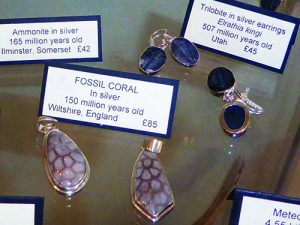
Matt was able to get a paid consultancy toward full-time work in Glasgow when his girlfriend Kate got a job in Edinburgh. Following the dictates of love (much like my daughter and son-in-law), he landed in Edinburgh, where he eventually found a manager position at Mr. Wood’s Fossils. There, his formal education in geology paid off in better customer service. For instance, during our interview, we paused when a customer approached him and I heard him provide a succinct and clear explanation of the geology of Scottish Iona marble.
Such knowledgeable customer service is important to Matt. He views his role as not only providing a good range of quality, affordable specimens but also educating and interesting people in the scientific aspects of the fields of mineralogy and paleontology. He finds it particularly satisfying when customers who may never have had in interest in fossils suddenly find a particular specimen intriguing enough to buy and add to their homes.
Matt has followed up on his educational background as a coauthor on some scientific papers being done as a result of Stan Wood’s collecting. He also has his own personal collection of fossil teeth, but—per Matt—he doesn’t want to overwhelm his home with specimens and thus limits his collecting inclinations. (As someone with such an “overwhelmed” home, I need to take heed!)
Giving Back and Helping Grow Community
In addition to running his own business, Matt has been involved in local committees to encourage tourism in the Grassmarket district. Tourists form the bulk of the customer base there, but Matt also enjoys a local clientele. Many such Edinburgh residents frequent the shop during the Christmas season. The shop is closed on Christmas and Boxing Day and New Year’s, but otherwise remains open—and busy—pretty much every other day of the year. Matt’s staff encouraged him to stay open on Sundays when many other businesses might take a day off.
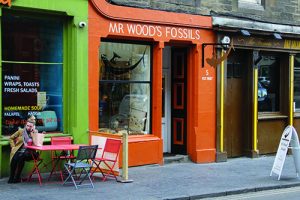
Mr. Wood’s Fossils
Matt Dale, Proprietor
5 Cowgatehead, The Grassmarket
Edinburgh, Scotland EH1 1JY
Telephone: 0131 220 1344
Website: www.mrwoodsfossils.co.uk
Email: shop@mrwoodsfossils.co.uk
To keep this Edinburgh institution alive, Matt has kept the shop similar in look-and-feel as during Stan Wood’s days; namely, a slightly cluttered but comfortable Victorian-era museum feel. This meshes well with the specimens on display and for sale and fits with the limited space Matt has at hand. He has slowly increased the number of more expensive pieces. These prove eye-catching and they do sell steadily, although customers for such items tend to be the exception rather than the rule. For instance, an American like me who intentionally comes looking for a rare Devonian fish from Scotland doesn’t walk through the door every day.
One noncommercial touch Matt has added is a bit of greenery with potted plants in the window to make for an inviting atmosphere. Also, to bring a fossil business into the twenty-first century, Matt maintains regular feeds and posts to Facebook and a blog with geologically relevant posts and stories, and you may contact him via email at shop@mrwoodsfossils.co.uk.
Throughout our interviews and during my earlier visits, Mr. Wood’s Fossils had a steady stream of customers, thus proving the wisdom of Matt in guiding Mr. Wood’s Fossils into a vibrant future. I belong to the Ventura Gem & Mineral Society in California, and as a result of my unabashedly shameless ravings about all things Scottish these past few years, at least two other members have visited Mr. Wood’s Fossils during trips to the UK, with another member planning a visit in the coming months. I encourage you, too, to make the trip to this rock shop of distinction. You won’t be sorry!



